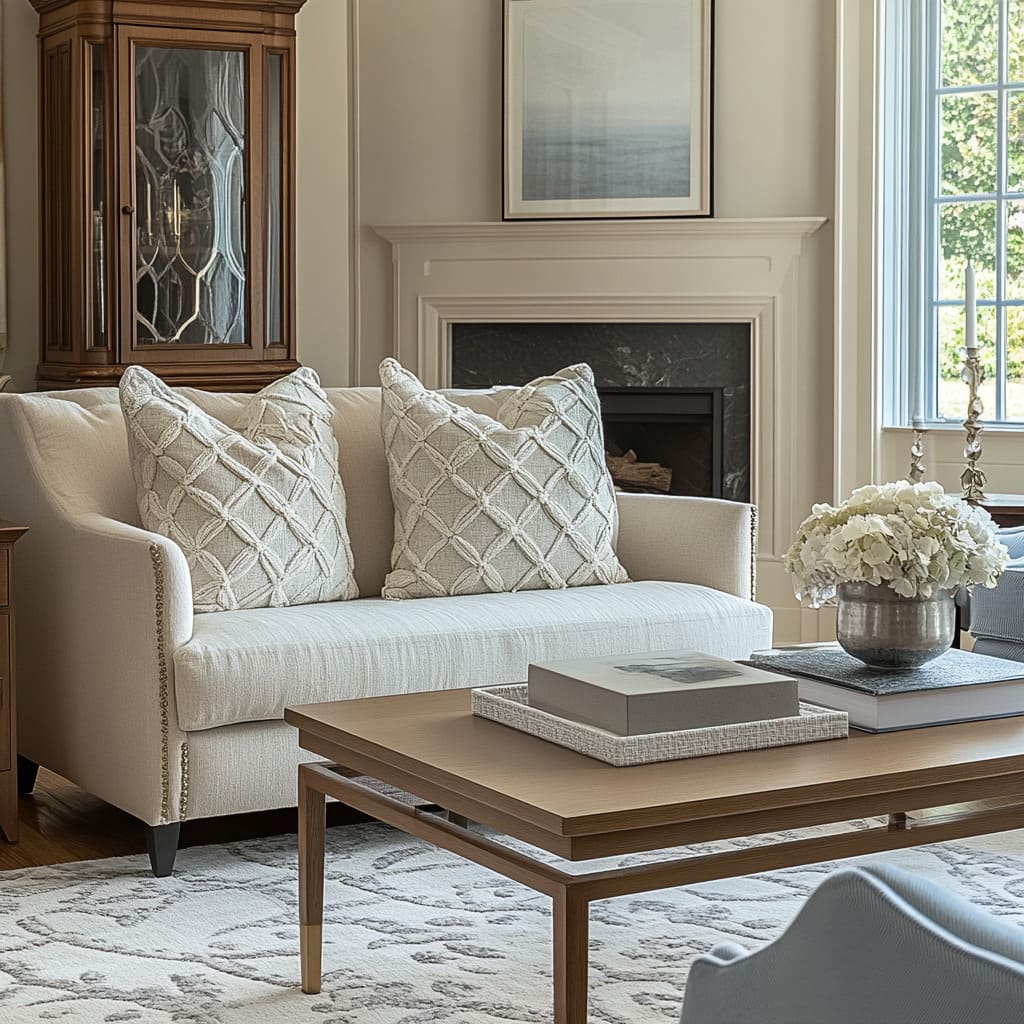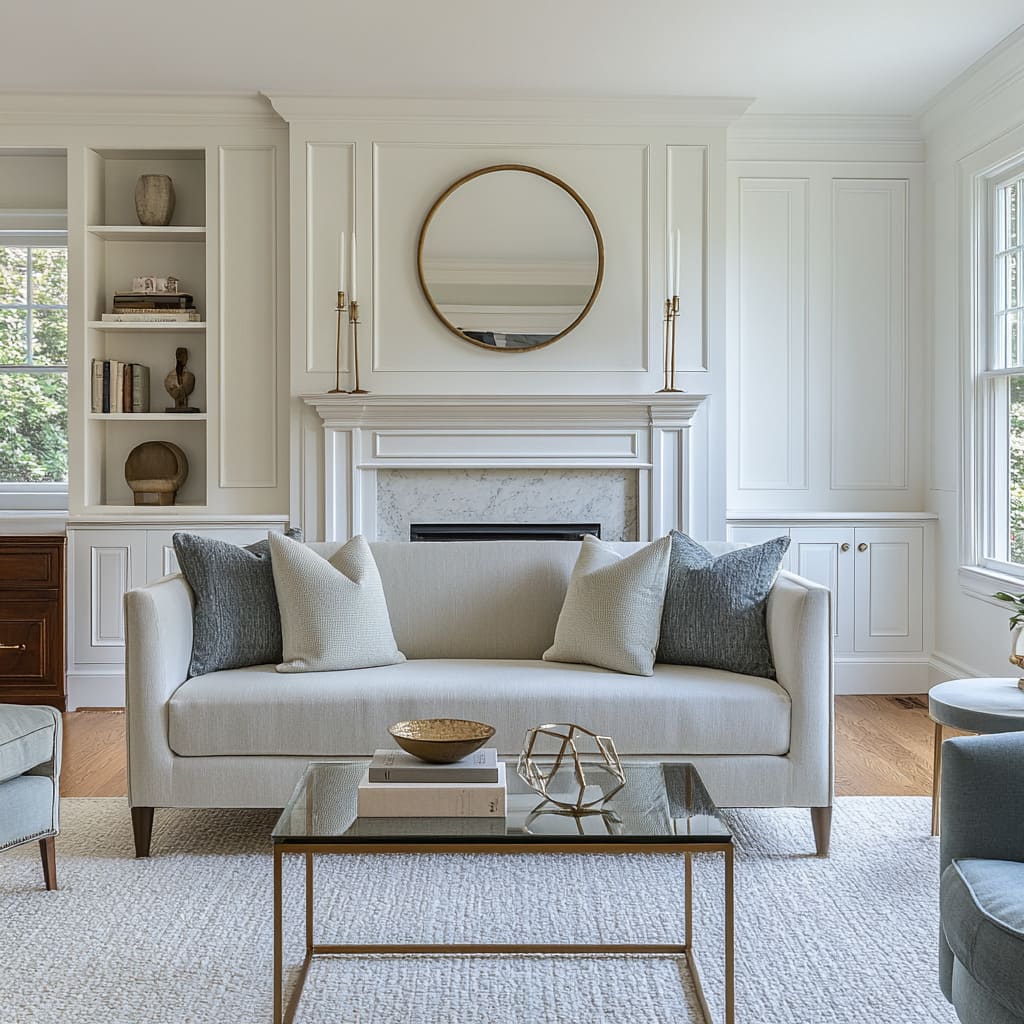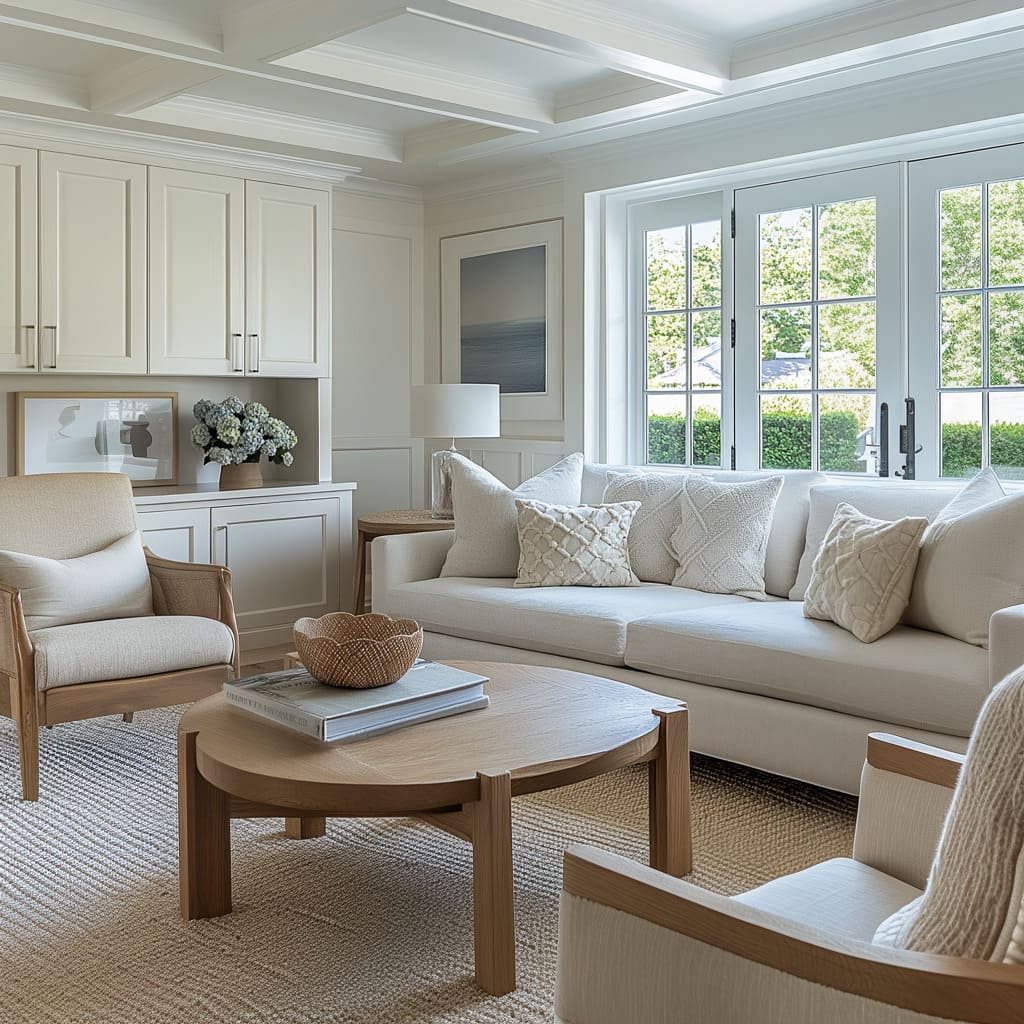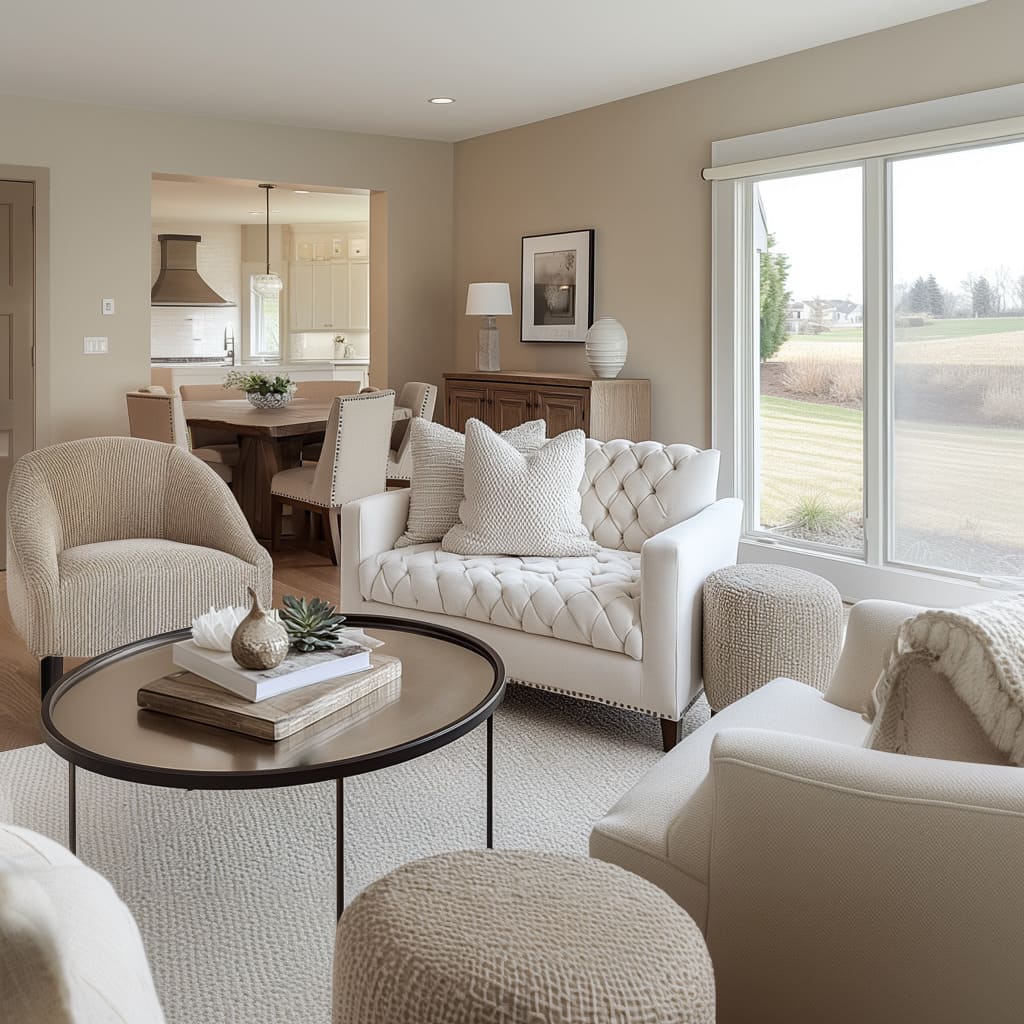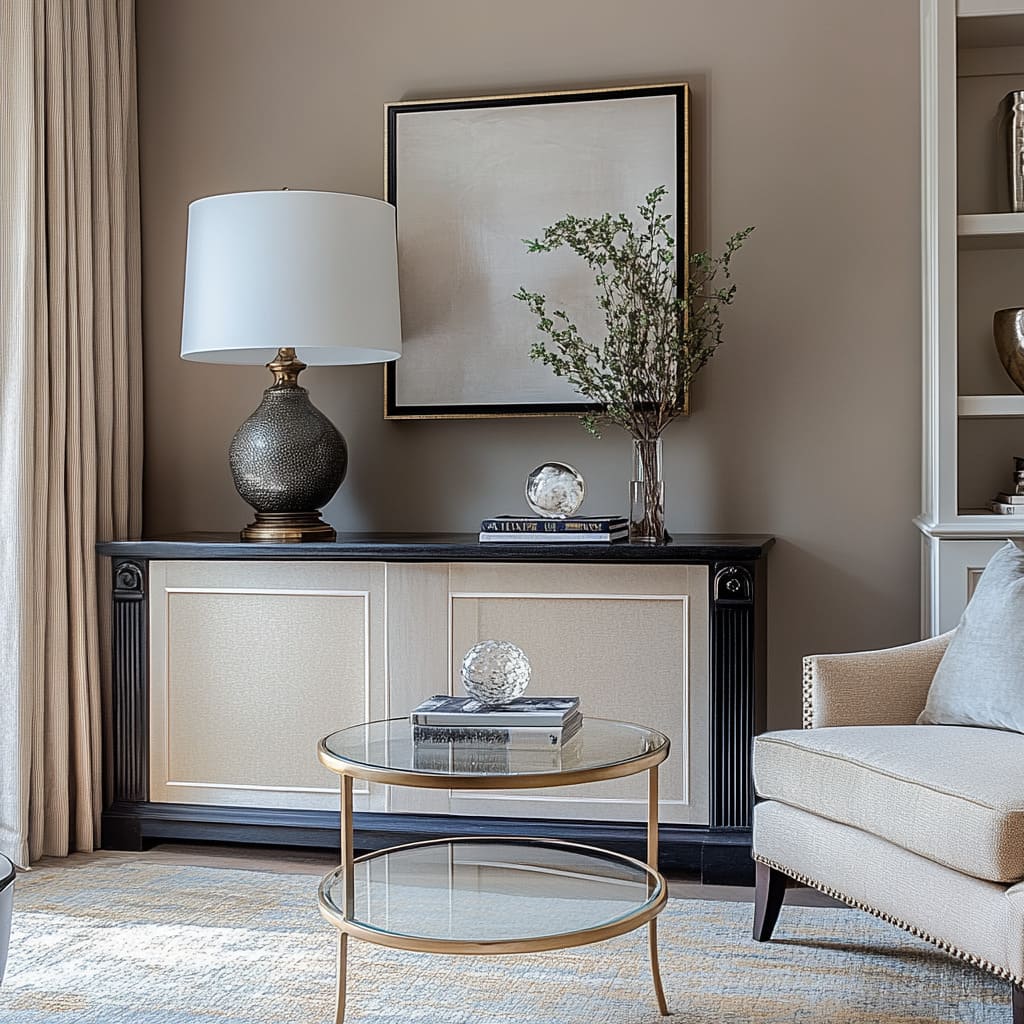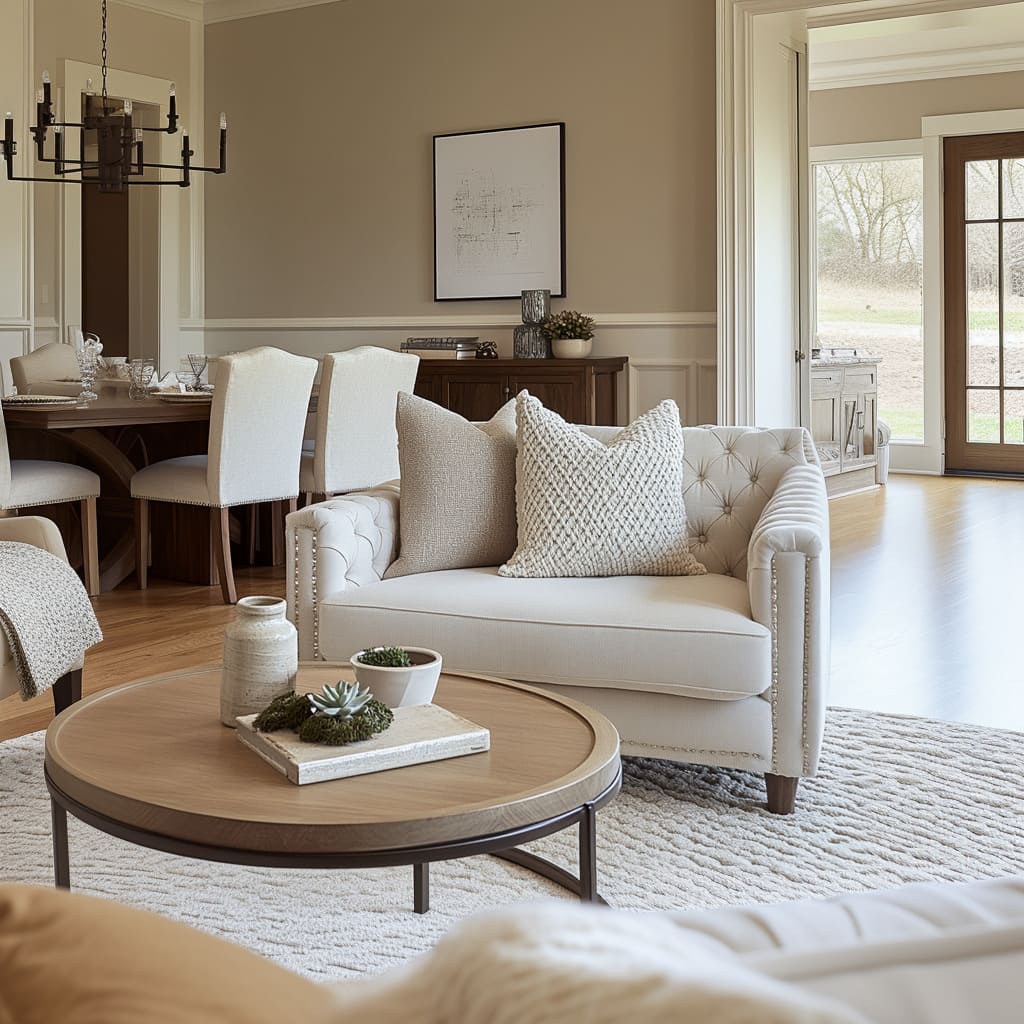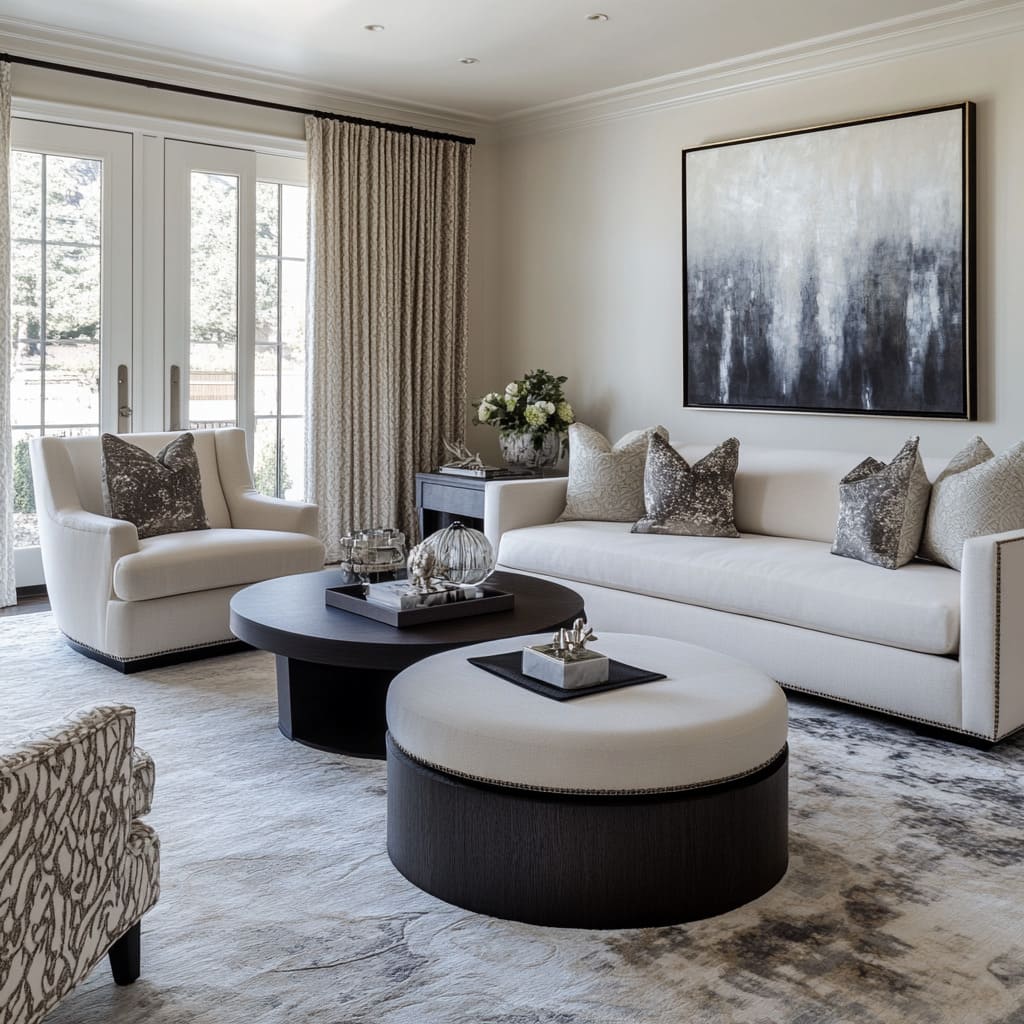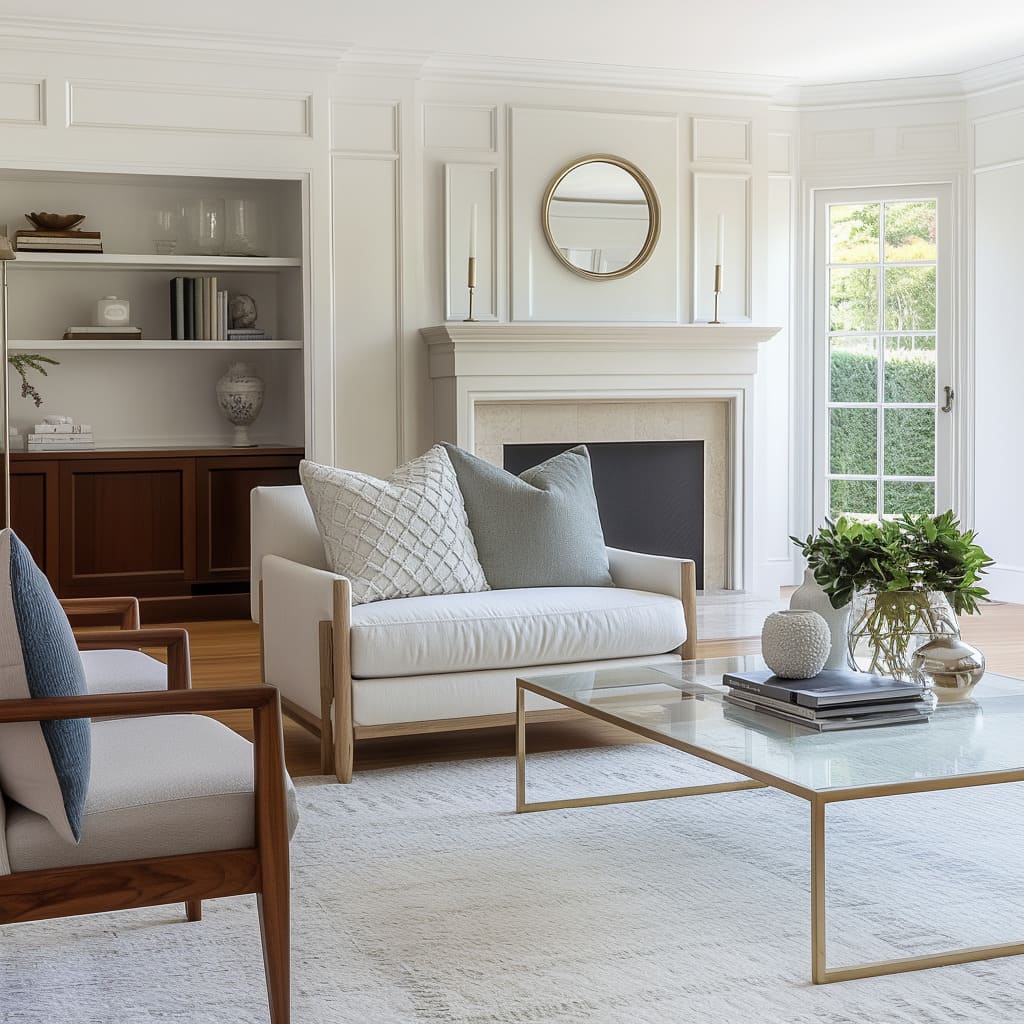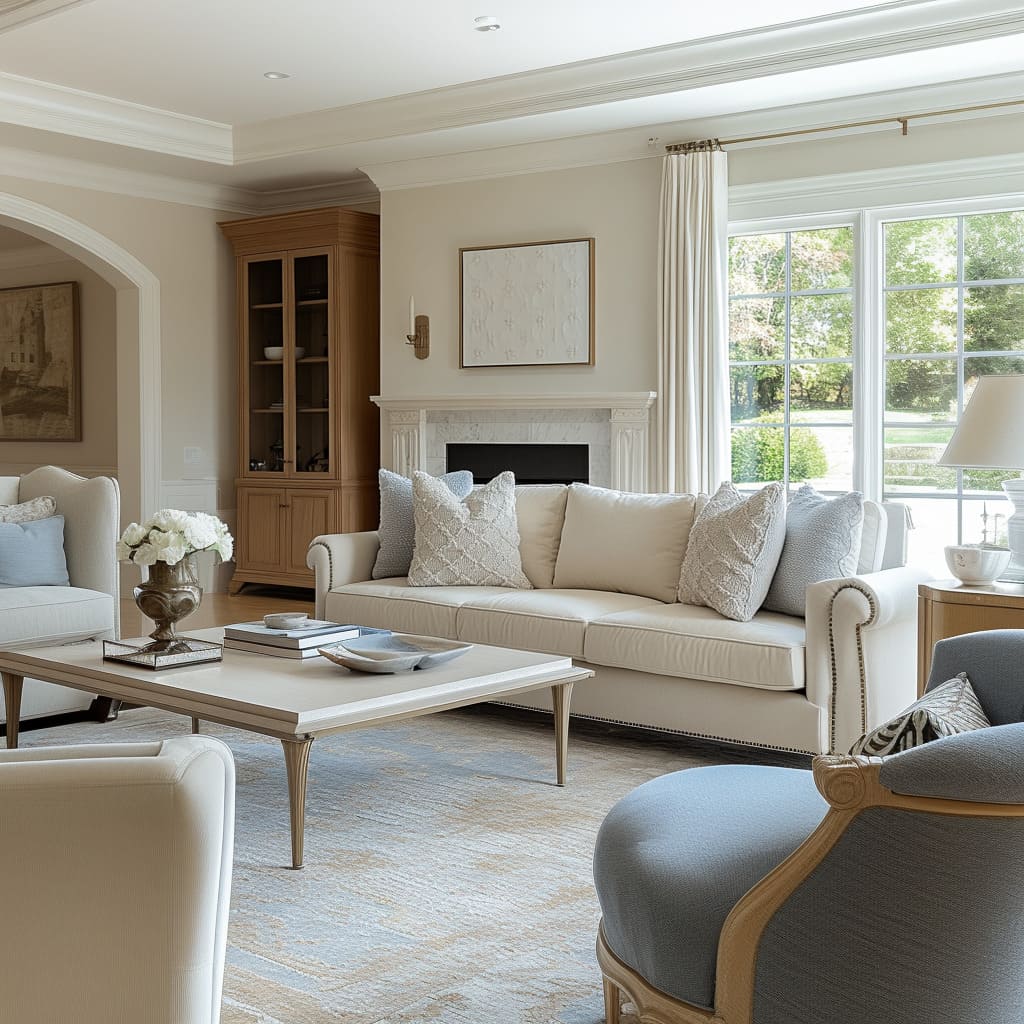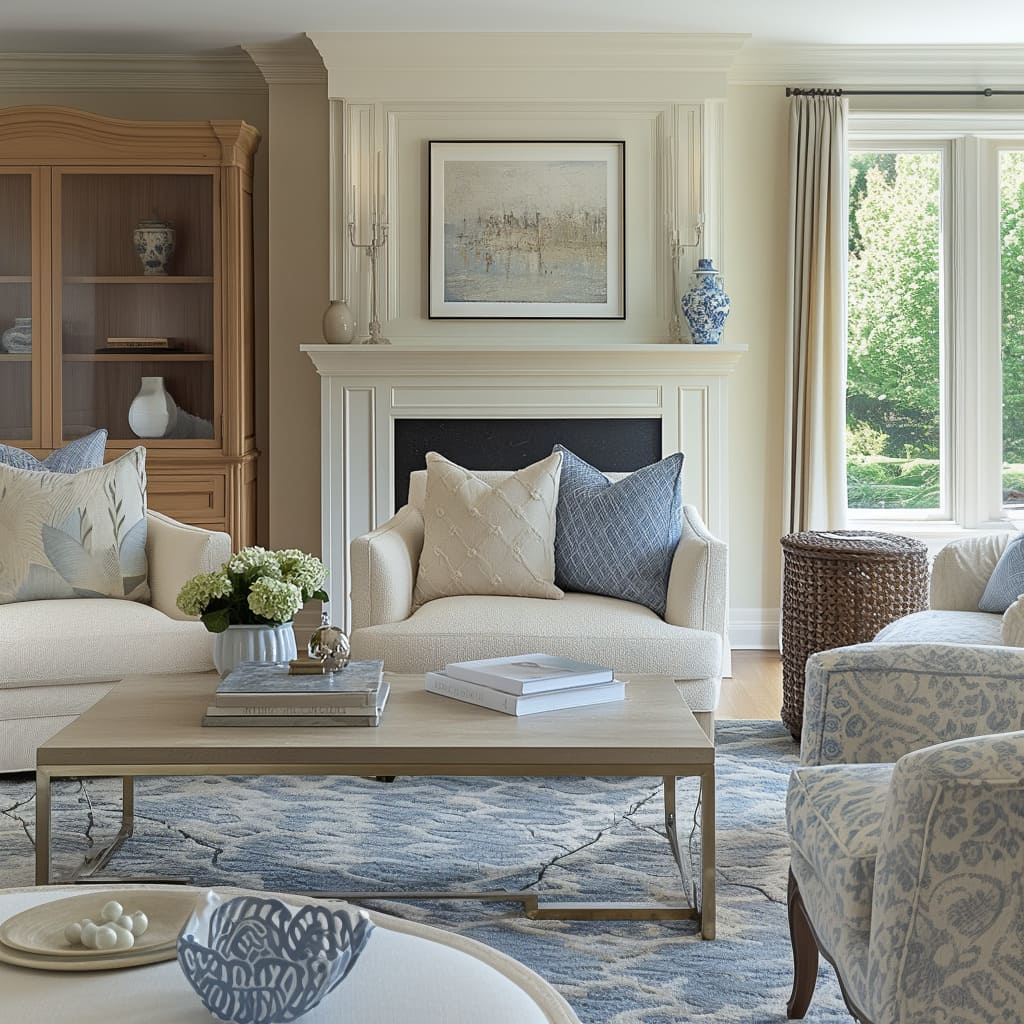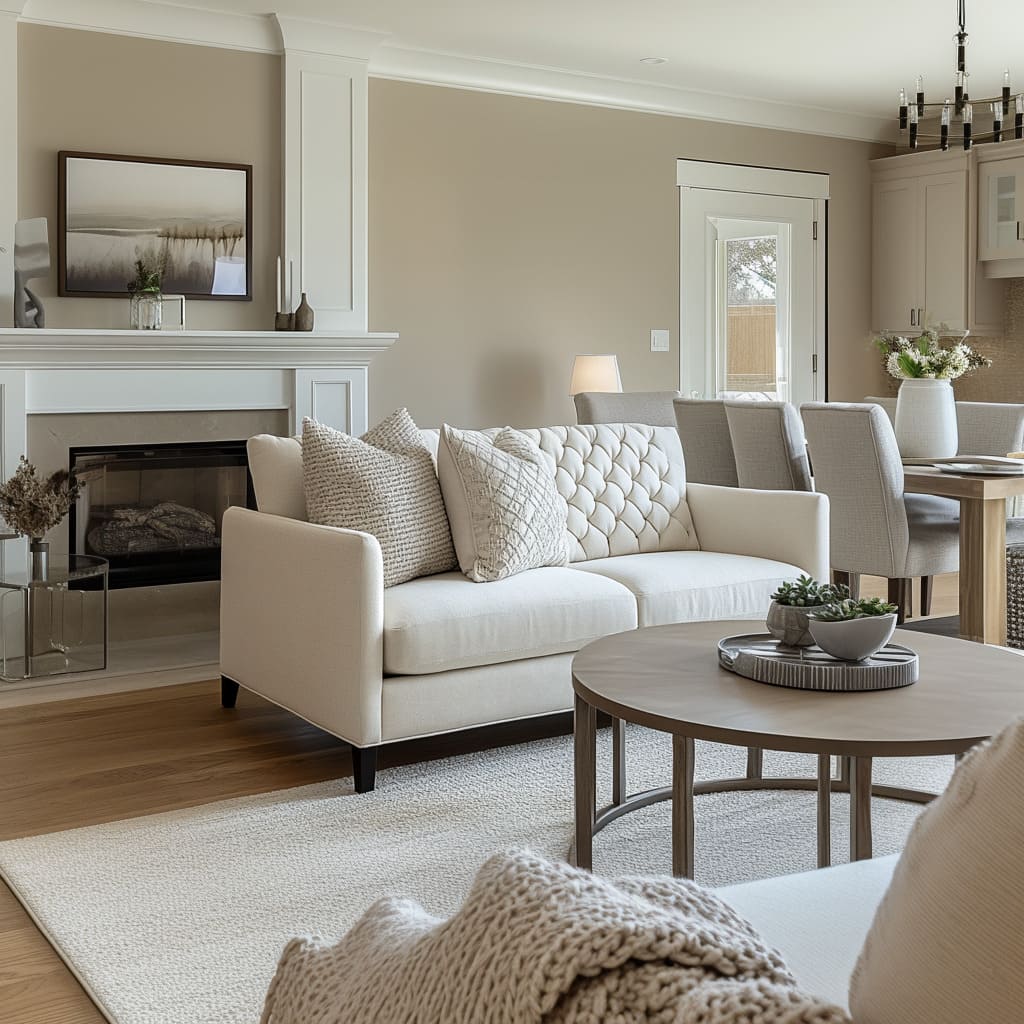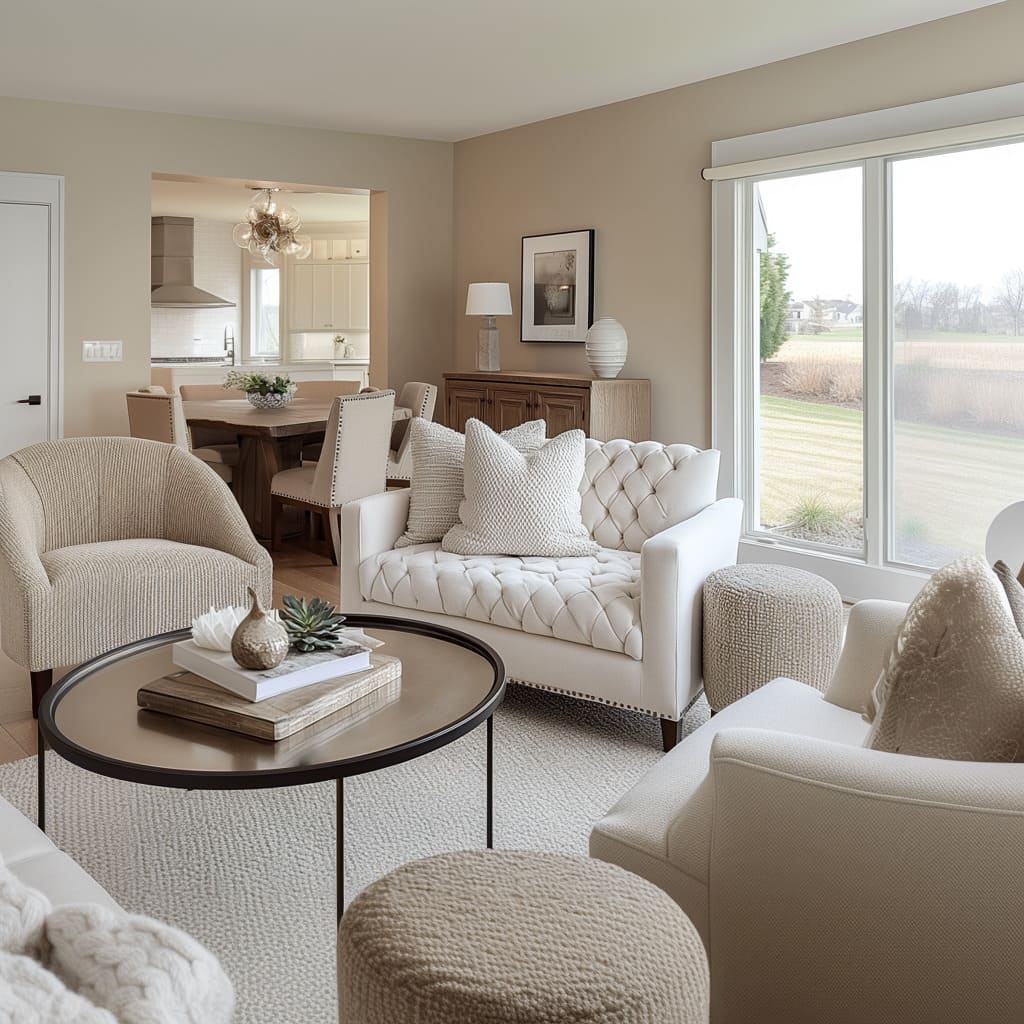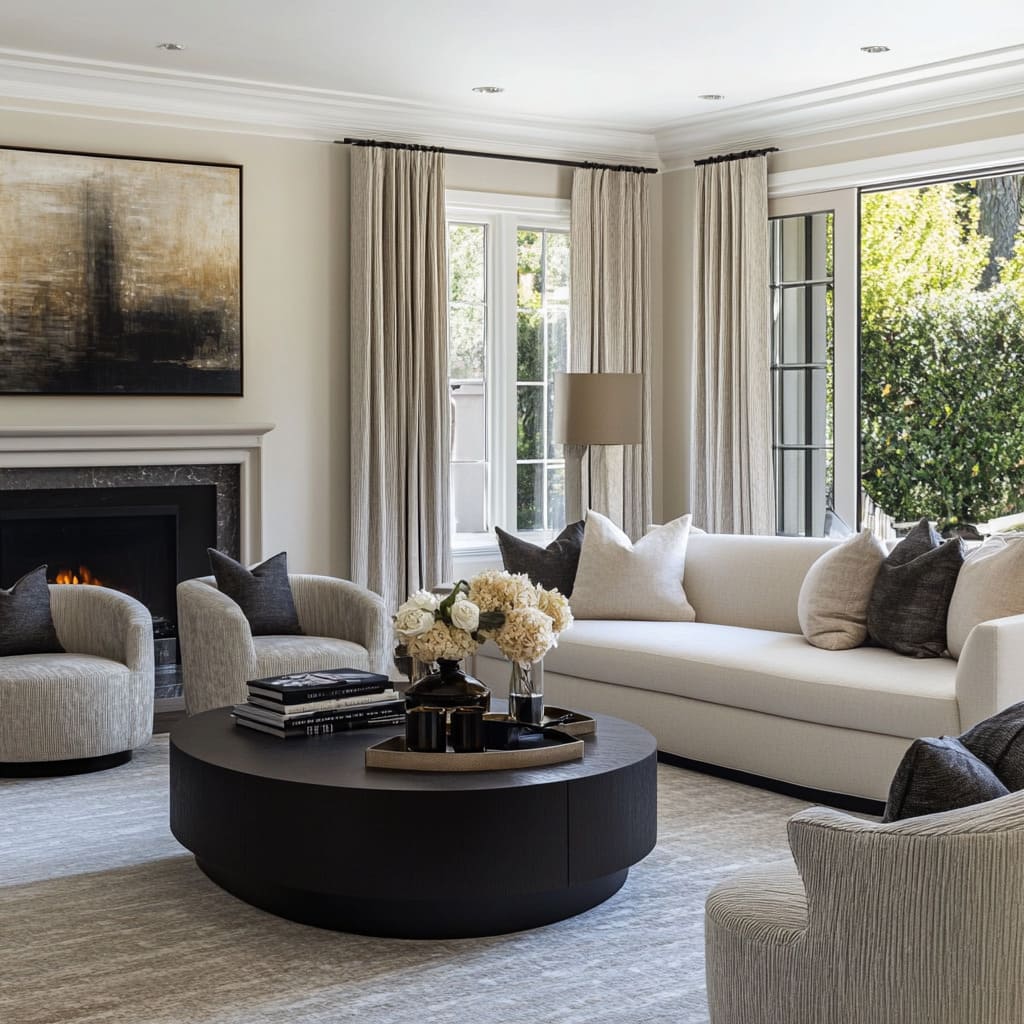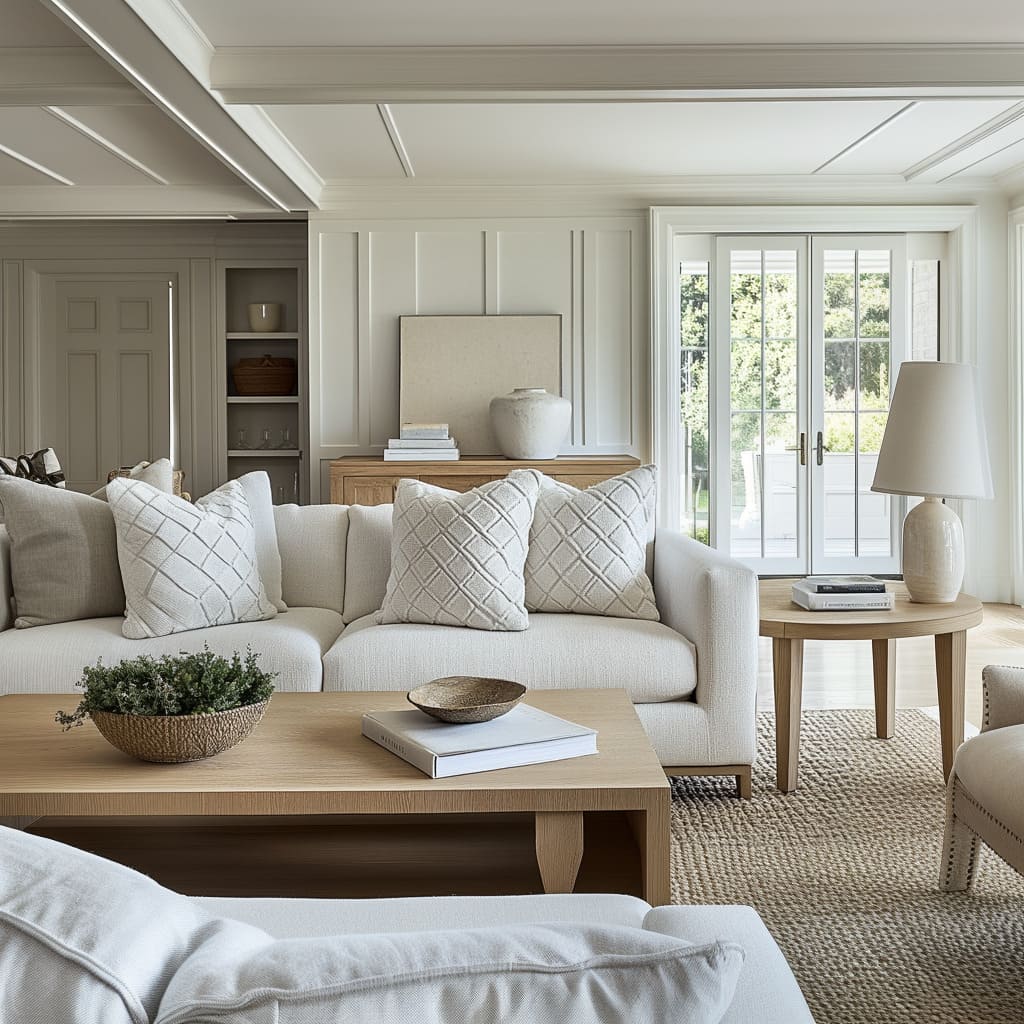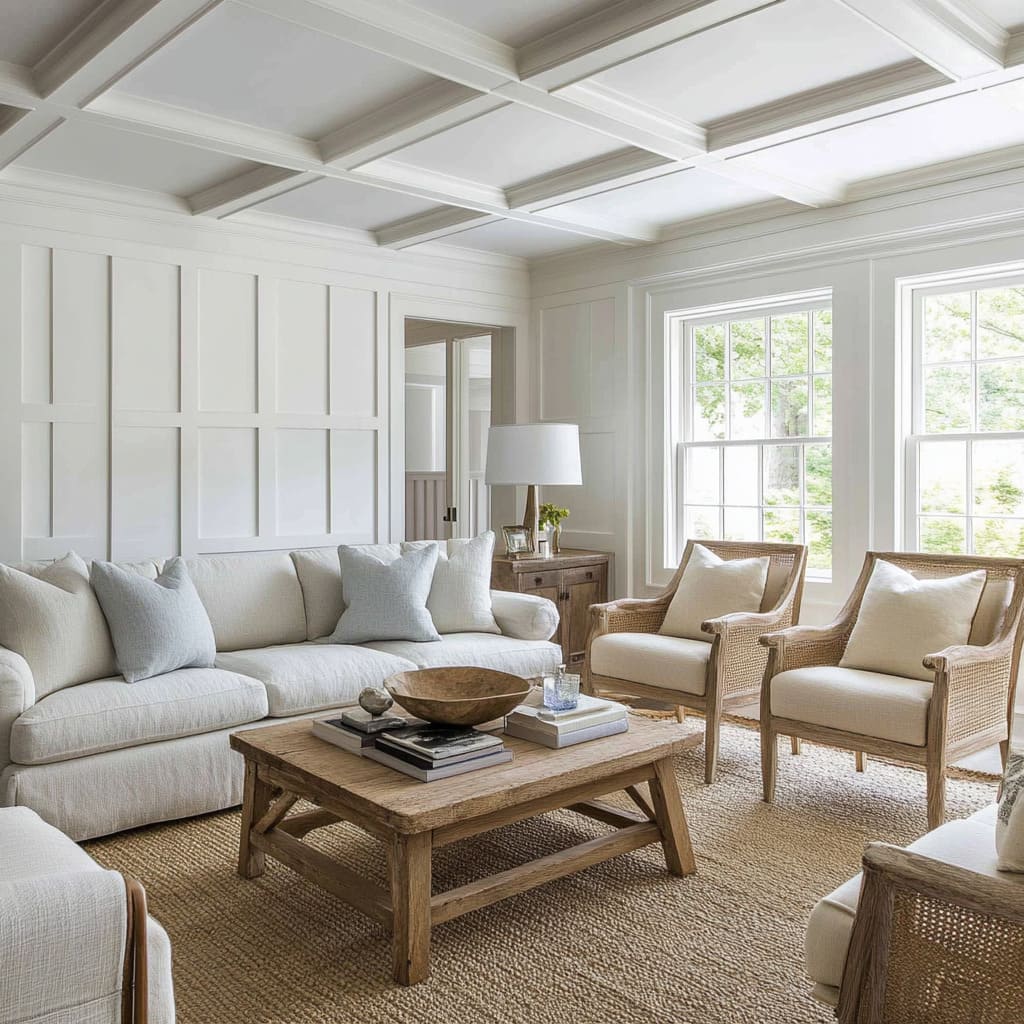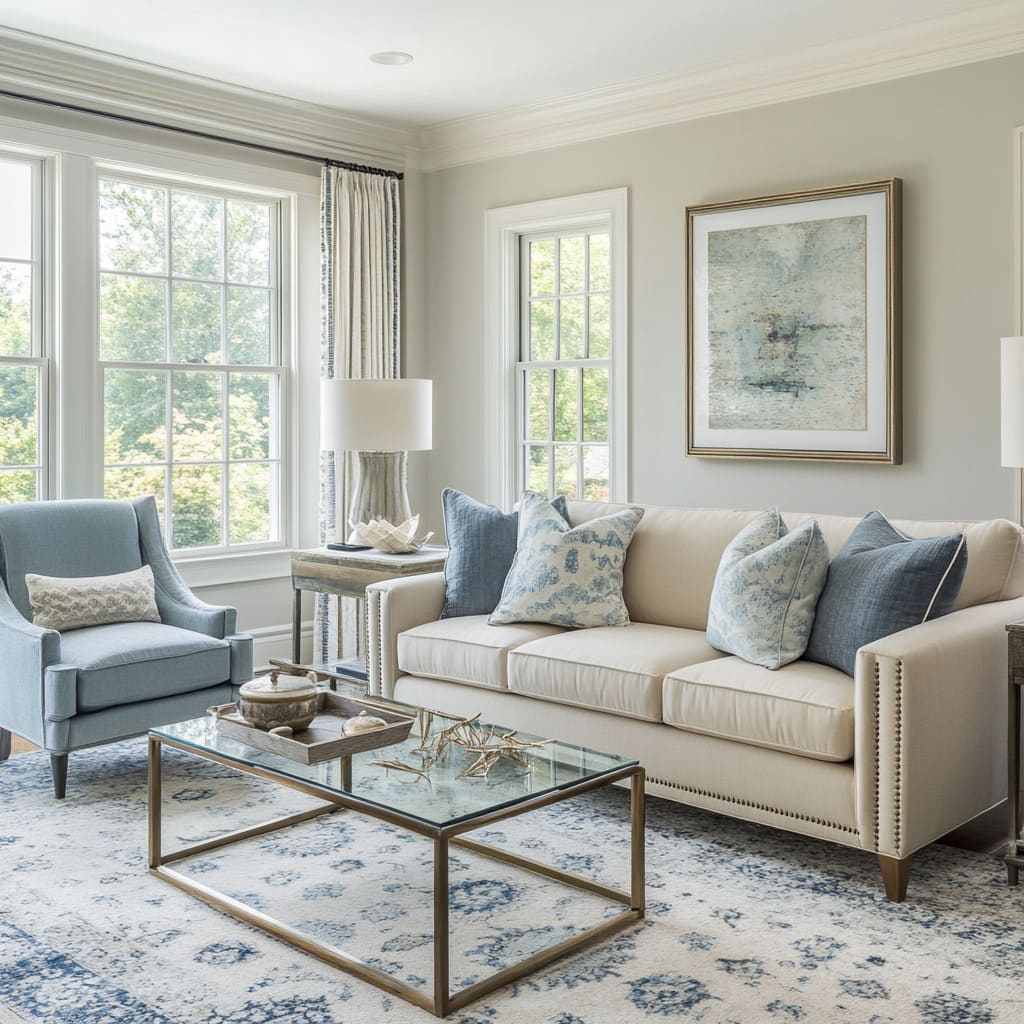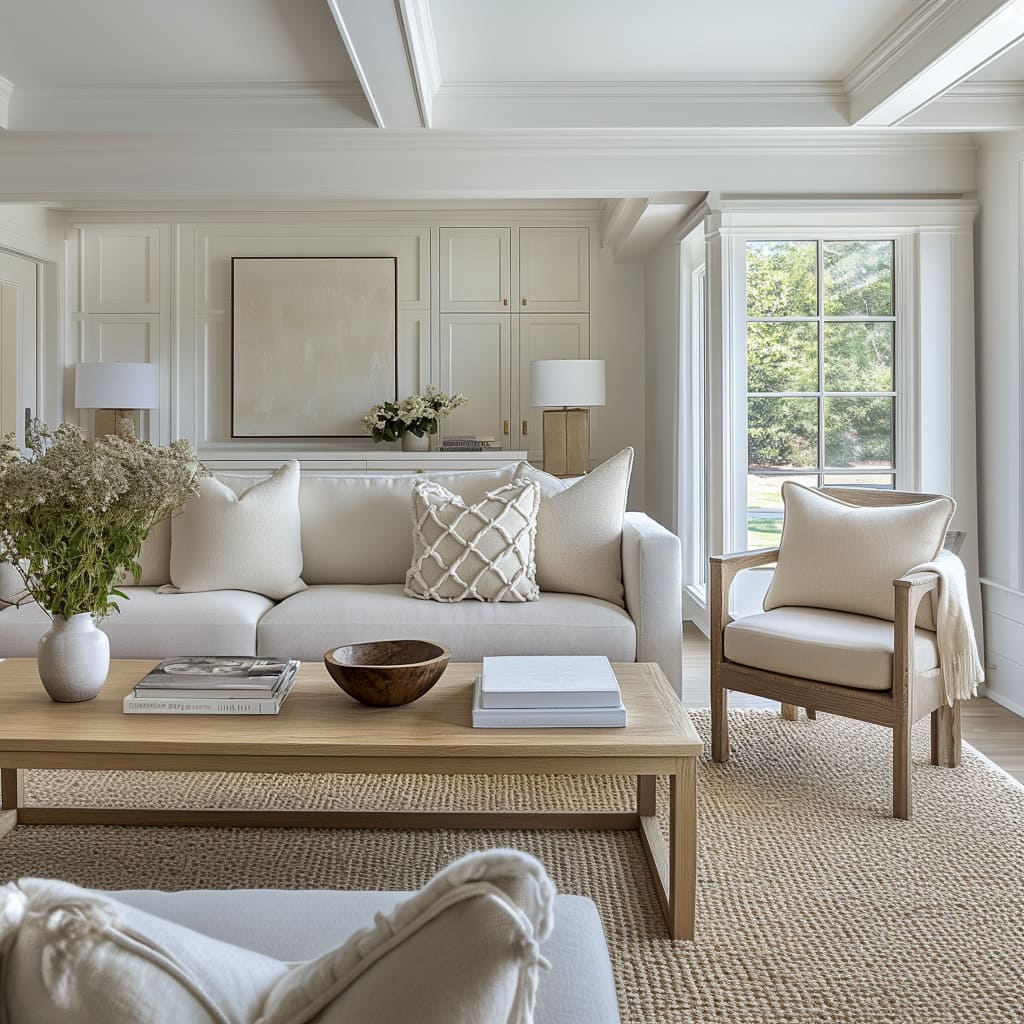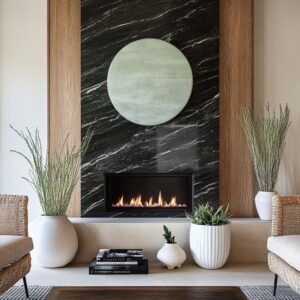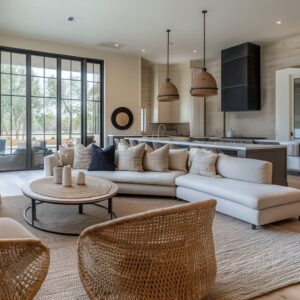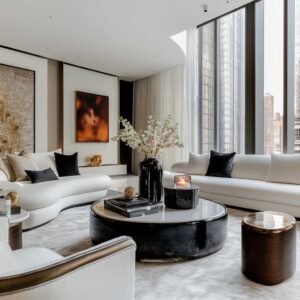Transitional living rooms have a unique way of blending the best of both worlds: the charm of traditional design with the clean simplicity of modern aesthetics. These spaces create a balanced, timeless appeal, offering homeowners flexibility and sophistication.
Whether you’re drawn to soft neutral palettes, thoughtfully layered textures, or a seamless combination of classic and contemporary elements, this style adapts beautifully to many settings. In this article, we’ll explore the defining features of transitional spaces, from furniture choices and material pairings to subtle details that bring warmth and character.
If you’re seeking a design that feels both polished and welcoming, transitional style provides endless inspiration for creating a home that feels perfectly yours.
Color Approaches That Define Transitional Living Rooms
Soft Neutral Foundations
Transitional living rooms often start with a palette grounded in soft neutrals—think creams, beiges, off-whites, and gentle grays. These shades form a clean canvas that allows furniture, decor, and textures to take center stage without overwhelming the space.
Neutral tones also provide a cohesive backdrop, especially in open-concept layouts where living rooms connect seamlessly to dining or kitchen areas. This continuity ensures a fluid, visually harmonious flow throughout the home.
Thoughtful Use of Accent Colors
Accent hues are sprinkled in sparingly to add personality and depth. Subtle blues, muted metallics, and hints of charcoal emerge through textiles, rugs, or smaller furniture pieces.
These tones complement the neutral foundation while creating visual interest. The restrained use of accents also bridges the traditional and contemporary elements that define this style, lending each room a sense of character while keeping it grounded in the overall design theme.
Monochromatic Layering
Instead of stark contrasts, transitional living rooms often embrace layers within the same neutral family. By incorporating slight shifts in tone and saturation—like pairing a soft beige sofa with cream throw pillows or adding a textured gray rug—rooms achieve a sculpted, dimensional effect.
This monochromatic approach delivers depth and warmth without the need for bold color splashes, maintaining the tranquil and balanced aesthetic that is a hallmark of transitional style. This combination of soft neutrals, restrained accent hues, and thoughtful layering transforms transitional living rooms into spaces that are cohesive, inviting, and timeless.
Layering Textures and Patterns for Transitional Living Room Ideas
Thoughtful Textiles
The foundation of texture layering in transitional living room ideas lies in the use of refined fabrics. Soft upholstery, delicately embroidered pillows, and patterned rugs work together to prevent the space from feeling flat.
Even when sticking to a neutral palette, subtle differences in weave, surface detail, or fabric pile add depth and visual appeal, creating a design that feels dynamic yet balanced.
Combining Smooth and Organic Finishes
Furniture pieces like coffee tables and sideboards often showcase a deliberate contrast between finishes. For example, a sleek glass or metal top might be paired with a natural wood base, balancing polished and rustic elements.
This interplay is a cornerstone of transitional design, blending clean lines with the warmth of organic materials. The result is a look that feels simultaneously sophisticated and approachable.
Natural Woven Accents
Accessories such as jute rugs, cane-backed seating, or seagrass baskets add an extra layer of texture while introducing a slightly rustic, handcrafted feel. These woven elements soften the design, balancing the clean, structured silhouettes of larger furniture.
Paired with sleek accents, they strike a perfect balance between casual comfort and refined style, embodying the essence of transitional living room ideas. This mix of fabrics, finishes, and natural elements creates a layered, inviting space that embraces both structure and comfort, making it ideal for a wide range of home aesthetics.
Defining Furniture Shapes and Silhouettes in Transitional Living Room Furniture
Harmonizing Curves and Lines
One of the hallmarks of transitional living room furniture is its balance between rounded and angular shapes. Circular coffee tables, barrel-backed chairs, and tufted sofas with gently curved arms are often paired with structured rectangular pieces like cabinetry or paneled walls.
This careful combination keeps the aesthetic balanced, avoiding extremes of either traditional or contemporary styles.
Subtle Tufting and Nailhead Accents
Decorative features like tufting and nailhead trim are thoughtfully incorporated into sofas and loveseats. These details, while nodding to traditional craftsmanship, are never overdone.
By keeping these accents understated, the furniture maintains a refined, streamlined look that complements both modern and classic elements within the space.
Exposed Wooden Frames
Armchairs and side chairs often showcase their wood frames, providing a subtle connection to traditional furniture-making techniques. The clean upholstery style of these pieces contrasts with the exposed wood, creating a perfect tension between vintage charm and modern simplicity.
This balance highlights the duality that defines transitional design, bringing harmony to the room’s overall composition. By combining curves with angles, intricate detailing with restraint, and natural wood with clean fabrics, transitional living room furniture achieves a timeless, versatile style that works beautifully in any setting.
Key Features That Define Focal Points and Architectural Elements in Transitional Living Room Designs
The Fireplace as the Visual Anchor
In transitional living room designs, the fireplace often takes center stage as the primary focal point. Whether it’s framed by a classic mantel, wrapped in marble, or accented with detailed millwork, it draws the eye and grounds the room.
Décor surrounding the fireplace, such as mirrors, artwork, or sconces, is kept minimal to maintain a sense of balance and prevent the space from feeling overly busy. This restraint allows the fireplace to stand out without dominating the room’s overall harmony.
Enhancing Spaces with Ceiling and Wall Details
Architectural features like coffered ceilings, understated moldings, and paneled walls add depth and sophistication to transitional spaces. These treatments guide the gaze upward, creating balance with the soft furnishings and décor below.
Even when intricate, these details are typically painted in neutral tones, ensuring they complement the room rather than overwhelm it. This combination of texture and subtlety highlights the vertical dimension while keeping the overall design cohesive.
Creating Balance with Symmetry
Symmetry plays a significant role in establishing the polished look of transitional living rooms. Seating areas are often arranged with precision, such as pairing matching lamps on identical side tables or positioning built-in shelving symmetrically around a fireplace.
This thoughtful layout creates a structured yet inviting atmosphere, striking a perfect balance between order and comfort. By emphasizing fireplaces, architectural details, and balanced arrangements, transitional living room designs achieve a timeless and well-composed look that feels equally at home in traditional or modern settings.
Material Choices and Finishing Touches in a Transitional Style Living Room
A Balanced Blend of Materials
In transitional style living rooms, a thoughtful combination of wood, metal, and glass brings depth and character without leaning too formal or too rustic. Wood is often used for tables, cabinetry, or exposed chair frames, providing a warm, natural foundation.
Glass frequently appears in coffee tables, display cabinets, or accent decor, adding lightness and transparency to the design. Metal, on the other hand, is applied sparingly in details like lamp bases, table legs, or decorative frames, contributing a refined contrast that elevates the overall aesthetic.
Soft Metallics and Reflective Elements
Metallic finishes are present but kept subtle, with brushed gold, distressed silver, and aged bronze being the preferred choices. These finishes add a hint of luxury without overpowering the room.
Reflective surfaces, such as mirrored or glass tabletops, further enhance the space by bouncing natural light throughout. This thoughtful interplay creates a sense of openness, even in smaller rooms, while maintaining the understated elegance of transitional design.
Natural Greenery as a Finishing Detail
Greenery plays a key role in completing the look of transitional spaces. From delicate branches in glass vases to leafy plants or arrangements of white hydrangeas, these organic touches bring a sense of life and vibrancy.
They also break up the neutral tones often used in these rooms, adding a refreshing element that feels welcoming and relaxed. By blending these materials and adding natural accents, transitional style living rooms strike a perfect balance between polished and approachable, making them adaptable to a variety of homes and preferences.
Accessory Styling That Elevates Transitional Living Room Inspiration
Thoughtfully Curated Decor
In transitional living room inspiration, accessories are carefully selected to avoid visual clutter while maximizing impact. Tabletops and shelves often feature just a few items—such as a couple of vases, a neatly stacked set of books, or a sculptural object.
This deliberate restraint ensures that each piece feels significant and enhances the overall aesthetic rather than overwhelming the design.
Balanced Pairings for Harmony
Balance is a key principle, reflected in the use of matching pairs and complementary groupings. Side tables frequently come in sets of two, lamps are often mirrored on either side of a sofa, and pillows echo patterns or colors across the room.
Even when asymmetry is introduced, such as in chairs of differing shapes, elements like color, texture, or proportion are used to unify the look. This harmony reinforces the transitional style’s ability to seamlessly blend traditional and contemporary elements.
Art That Complements
Artwork plays a supportive role in tying the space together. Abstract pieces, often rendered in neutral or softly contrasting tones, enhance the room’s palette without overpowering it.
Mirrors are another popular choice, especially above fireplaces, where they serve dual purposes: reflecting natural light to brighten the room and acting as understated focal points that don’t compete with furnishings. By embracing thoughtful placement, balanced pairings, and carefully chosen art, transitional living room inspiration proves that less is often more when it comes to creating a space that feels both curated and welcoming.
Emerging Trends in Transitional Family Room Decorating Ideas
Vertical Design for Expanded Spaces
Transitional family room decorating ideas often emphasize vertical elements to enhance spatial perception. Tall drapes, extended fireplaces, and floor-to-ceiling built-ins create a sense of height and openness, drawing the eye upward and making the room feel more expansive.
This design approach balances the horizontal layout of furniture and other decor pieces, ensuring the space feels both structured and inviting.
Seamless Flow in Open-Concept Designs
In open-concept layouts where living, dining, and kitchen areas merge, maintaining consistency in color and materials is key. Neutral palettes, recurring furniture finishes, and matching accessory styles—like repeated use of ceramic vases or subtle metallic touches—act as cohesive threads, visually connecting the zones.
This creates a harmonious flow between spaces, ensuring they complement rather than compete with one another.
Layering Patterns with Scaled Variety
Patterns are thoughtfully layered across rugs, pillows, and decor to keep the design engaging without overwhelming the senses. A rug may feature a bold, large-scale motif, while medium-scale patterns appear on pillows, and smaller, subtle textures are found on accent items like bowls or throws.
This careful variation in scale ensures the room feels dynamic while retaining a balanced look.
Defining Zones with Area Rugs
Area rugs play a crucial role in softly delineating functional zones within transitional spaces. For instance, a rug under the seating arrangement anchors the conversation area, while creating separation from adjacent walkways.
When rugs reflect the room’s accent colors, they further unify the overall design, subtly linking the floor treatment to the rest of the decor.
Adding Depth Through Contrast
Although light tones dominate the palette, the introduction of select dark pieces—such as a black coffee table, deep-toned throw pillows, or a feature wall—creates contrast and adds dimension. This strategic use of darker elements draws attention to specific focal areas, enriching the overall aesthetic without overpowering the space.
By combining vertical elements, consistent materials, carefully layered patterns, and contrasting tones, transitional family room decorating ideas strike a balance between cohesion and individuality, making the design both timeless and adaptable to different settings.
Conclusion
The examples explored in this article reveal how transitional style effortlessly combines timeless craftsmanship with contemporary simplicity. Tufting, nailhead trims, and paneled millwork echo traditional elegance, while streamlined furniture frames and minimalistic decor speak to a modern sensibility.
This harmonious blend is grounded in soft, neutral palettes and an intentional interplay of materials—such as wood paired with metal, or glass complemented by plush textiles—ensuring every element feels thoughtfully curated. What truly sets these designs apart is their masterful approach to layering.
Patterns are introduced sparingly yet with variety, textures complement each other without overwhelming the space, and focal points are defined without becoming overstated. Each space showcases the art of balance, seamlessly weaving traditional and contemporary details into a unified and inviting design.
For those looking to create spaces inspired by the transitional aesthetic, these images of transitional living rooms offer a wealth of ideas, from refined material combinations to carefully layered textures. They serve as a testament to how depth and cohesion can coexist, making this style a timeless choice for any home.
